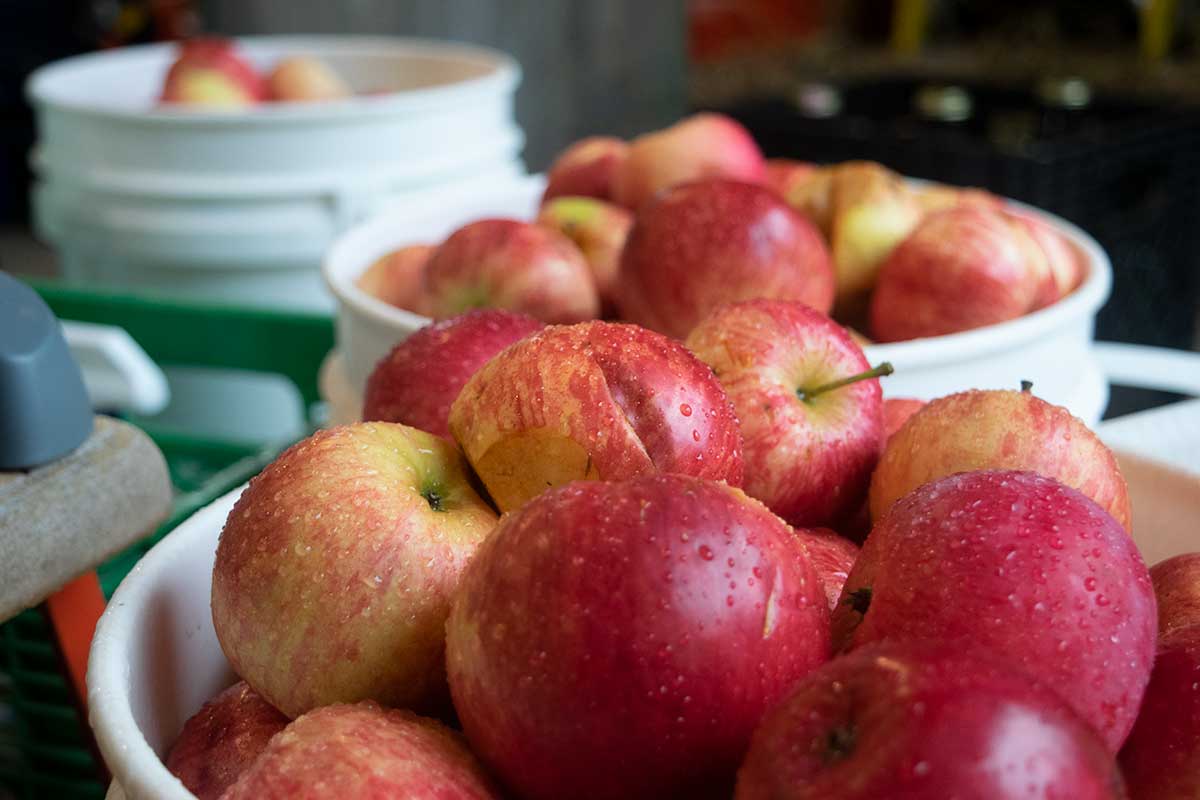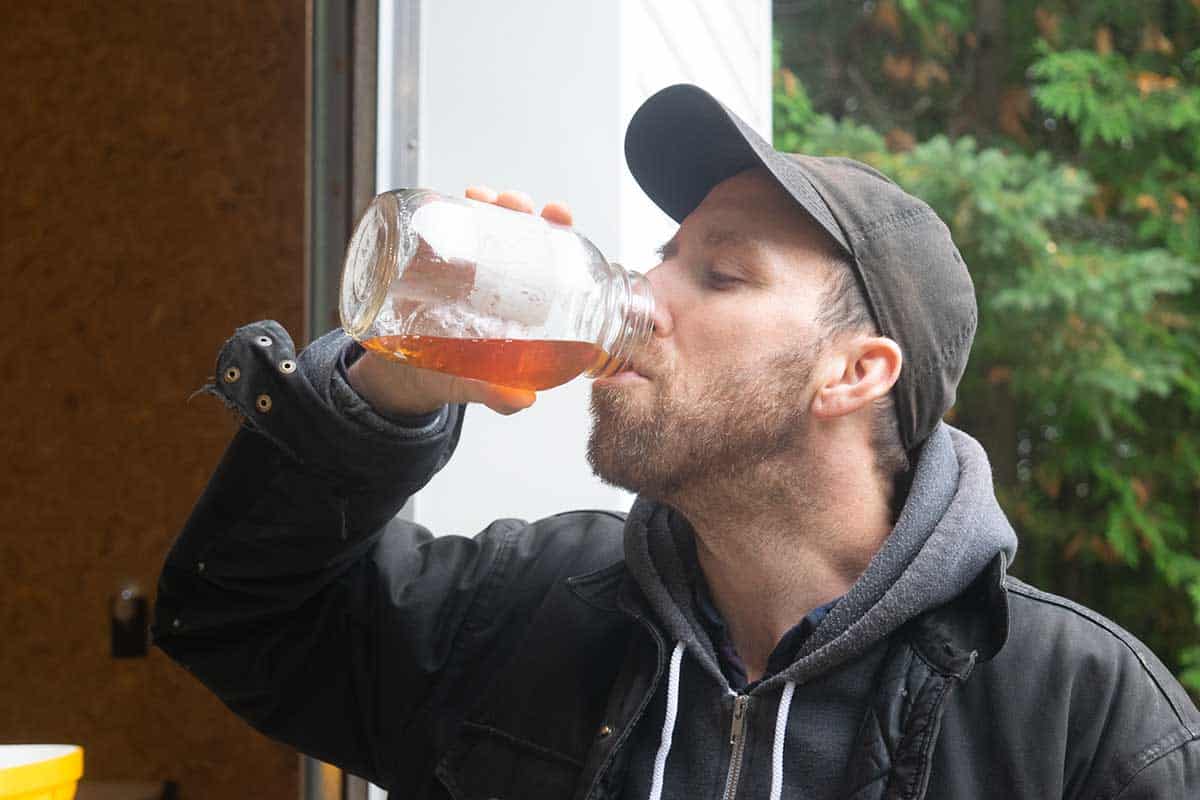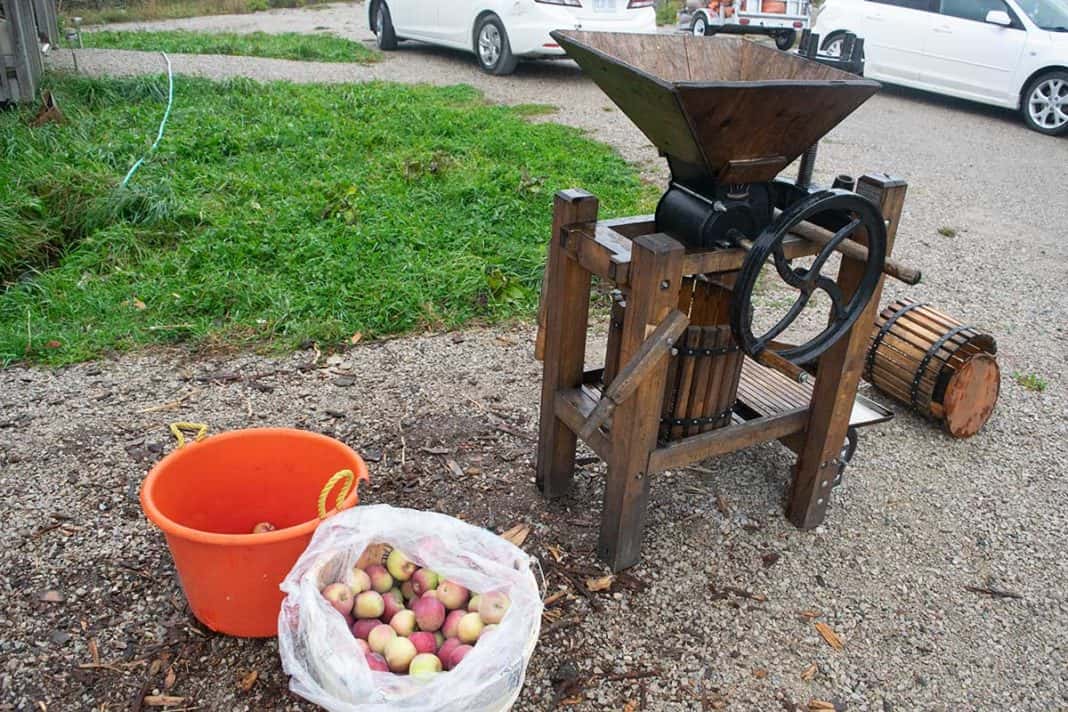MANITOULIN – Islanders who are fortunate enough to have apple trees on their property may be wondering what to do with their harvest that hasn’t already ended up in pies, tarts or sauces. For a tasty treat that will help preserve the fruit for a bit longer, cider may be your answer.
This author is a self-professed lover of all things apple and when my father offered to bring up a 50-pound bushel of macs when he visited me for my birthday, I was all in. I have long wanted to make my own cider but my lack of knowledge intimidated me.
Apple cider can take many forms. It can be fresh-pressed and preserved in that state, it can become fizzy ‘lady cider,’ it can ferment into hard cider or a potent ‘apfelwein,’ or it can become a stable apple cider vinegar.
My goal is somewhere in the lady cider or hard cider range but I know I won’t get there alone. I turn to Justin Tilson’s Resilient Manitoulin community for support.
Just five hours later, I already have a handful of leads and offers from people willing to show me how it’s done.
• • •
The first person who fits within my schedule is Jaime Rowntree, a member of the Northern Ontario Permaculture Research Institute (NOPRI) in Honora Bay, of which Mr. Tilson serves as executive director.
The institute’s science director Mark Hamalainen has previously purchased some commercial equipment but the COVID-19 pandemic has him stuck in California, away from the gear at his parents’ home in Little Current. He hopes to launch his small commercial cidery in the near future (tentatively called Wild Island), but in the meantime, NOPRI members are able to make use of his machinery.
Ms. Rowntree shows up at the Hamalainen house with a small crew from NOPRI on a cool September morning and begins to unload some of the equipment. Soon, a platoon of devices stands ready in the garage—a masticator to grind the apples into a pulp, a hydraulic press to extract all of the cider from the apples, plastic containers to hold the juice and a plastic tub of water to rinse the apples before they meet their grinder.
The team sanitizes any surface that will contact the fresh cider to make sure no contaminants taint the batch.
“It’s go time,” says Ms. Rowntree as the crew begins to wash and grind pailfuls of apples and load them into the press. Once full, the team attaches a hose to the contraption’s bladder and water pressure squeezes the juice through a fine metal screen.
It takes about 10 minutes for these machines to make a gallon of cider and the team takes a celebratory swig. Ms. Rowntree adds two strains of wine yeast to ferment the batch in the way they want and then she and her teammates race off to harvest more apples.

As I enjoy my cider sample, I realize that I have more questions than answers. I don’t have access to this fancy gear and wonder how I’ll process my own bushel.
Enter Mary Yett.
• • •
Ms. Yett has lived in Tehkummah for 13 years and works as a veterinarian. Her background is in herbalism and microbiology.
She has been making her own apple cider, apple cider vinegar and other food preserves for 30 years and is a fierce advocate of permaculture.
“Part of my goal in life is to help people learn to take care of themselves. The times have changed away from self-reliance but Manitoulin is a great place to share knowledge and rediscover some of the old techniques,” says Ms. Yett.
Making cider doesn’t have to be daunting, she says, and she’s determined to prove that to me.
I’m in.
We eventually find a time that works in both of our busy schedules—a rainy, mid-October Sunday morning.
• • •
A few days before the trip, it occurs to me that I should have a carboy or two (also known as a demijohn), a sturdy glass jug to catch the fresh juice and hold it as it ferments.
It’s back to Resilient Manitoulin in search of containers. I get a few offers to borrow gear and opt to look at Richard Edwards’ two carboys with rubber airlock stoppers, but as I start my car to drive over I learn that they’re five gallons in size, likely too large for my single bushel.
The going estimates equate one bushel to roughly a gallon of juice.
I graciously accept them, just in case, and continue my quest for a pair of gallon-sized containers.
Paul Best then offers me a plastic carboy but it, too, is five gallons in size. However, it weighs a fraction of the glass units and so I agree to hold onto it for a week.
Gary Furhman then comes to my rescue and I stop in at his off-grid home to gather a pair of glass gallon jugs that perfectly suit my needs.
I sanitize all of the containers that evening and begin the trek to Tehkummah in the morning.
• • •
It’s easy to spot Ms. Yett’s driveway. Resting there is an ancient-looking wooden and metal press that seems to weigh a ton or two—we discover this to be true as we try and fail to move it out of the rain.
The first step is again to wash the apples and run them through a hand-cranked grinder. I take on loading and cranking as Ms. Yett uses a stick to motivate the apples into the teeth of the grinder.
We grind the apples whole. Even ones with small blemishes or squirrel bites are okay, as long as there is no rot.

“We’ve been trained to look for produce that’s visually perfect, but often the healthiest ones are the ones with little imperfections. Many of the apples here on the Island have evolved to be disease-resistant,” says Ms. Yett.
Once the barrel is full of pulp, it’s on to the pressing stage.
The design of apple presses has not changed much through the years: a barrel to hold the pulp, a wooden lid to cover the apple bits and a metal rod to apply pressure for squeezing out the juicy goodness.
As we work, Ms. Yett shares factoids about the benefits of cider and other fermented foods.
“Every culture on the planet eats some sort of fermented product every day. We need that for our gut health, which is often weaker in our society,” says Ms. Yett, adding that gut microbes make up the vast majority of one’s immune function. Imbalances in the gut can cause immune disorders, allergies and other health problems.
She asks what containers I’ve brought to hold the juice and I show her my sterilized bottles, as well as the airlocks that I’ve seen recommended online.
“This is all fine, but you really don’t need all of this and you don’t need to go through a big sterilization process,” she says. I ask about the online articles I’ve read on the topic that warn of molds and other contaminants ruining batches but she assures me that for most casual home experimenters, a hot soapy water wash should be sufficient.
Ms. Yett occasionally teaches classes about how to graft trees but says birds have naturally planted almost every tree on her 100-acre property. She tells me about the purpose of permaculture studies—to optimize plant growth and find companion species that can increase their natural food output and balance the ground’s nutrient levels.
“Most cultures die off in hundreds or thousands of years because of bad soil practices. You need animals on farmland and regenerative agriculture practices to complete the nutrient cycle,” she says.
• • •
In short order, we’ve ground and pressed my whole bushel, except for a couple of bad apples that land in her garden for fertilizer. The long handle on the press means it’s not too challenging to squeeze out the juice, but every so often an apple mash projectile squeezes through a slat of the barrel.
By the time all of the pressing is done, my clothes are soaked both from the rain and the apple bits, but I’m unfazed. I hold up the gallon-and-a-bit of rich, brown cider that we’ve pressed, including a foamy head and the little bits of apple that slipped through into the jug, and smile.
We spend about 20 minutes hosing down the apple remnants off the press, then transfer the dried-out apple mash to a bucket. It, too, will go into the garden as fertilizer.
I’m thrilled but also rather chilly, so I invite myself into Ms. Yett’s kitchen for a mug of tea so I can learn more about her background and gather tips for home cider makers.
The manual method is more accessible than the industrial equipment at NOPRI, but it still requires harder-to-find gear, unless a fellow Islander is willing to loan theirs out.
I mention this to Ms. Yett. She stands and brings over a tall metal contraption to the kitchen table.

“This is a steam-juicer,” she says as she plunks it down and takes it apart. It has three chambers—a water reservoir at the base, a central component to hold the juice and a colander-type top to hold fresh fruit.
“You set this on the stove and let it cook down into juice, and then you can fill jars with this spigot,” she says. “It’ll be pasteurized so it won’t ferment on its own, but for maybe a hundred dollars or two, this is the easiest way to get into making ciders and juices at home.”
Those who prefer not to cook down their fruit can also grind, blend or fine-chop their apples and press them through cheesecloth for the same effect, albeit with more effort.
Manitoulin Island hosts an abundance of apple trees and Ms. Yett says aspiring cider-makers can likely find plenty of fruit either for free or in exchange for finished product.
“If you see a tree on someone’s property, find the owner and ask if you can have some of them. It’s a good way to make friends and you can always return the favour after you’re done,” she says.
Any kind of apples can make a nice cider but the best results come from a blend of bitter and sweet varieties, says Ms. Yett.
• • •
We opt to use the natural yeasts that grow on fruit skins to ferment my batch, but I’ve brought commercially harvested apples that have been sprayed to kill such organisms. Ms. Yett adds in a splash of her apple cider vinegar to help kick-start the process in my batch, as it is full of the natural fermenting lactobacillus micro-organisms.
The cider can pick these up from the air (because they exist everywhere) but it can also attract un-helpful organisms like molds. Ms. Yett says she has spent years ‘inoculating’ her home with lactobacillus so her own batches reliably pick up the helpful micro-organisms.
With my cider pressed and boosted with Ms. Yett’s vinegar, now begins the hardest part—waiting. For people who choose to ferment their cider without airlocks, she suggests leaving the cap loose to let out gas. Use a plate underneath to catch any drips and leave the jug at room temperature in a visible location, such as a kitchen.
“You’ll want to taste it every day because it’s easy to let it go skunky,” she says. “It’ll start foaming and bubbling; when the foam stops and it’s still bubbling you have lady cider, which is like kombucha with a very slight alcohol content. It’ll keep going to become harder cider and eventually turn into vinegar.”
The key is to refrigerate the batch when it reaches the desired fermentation level to stop it from going any further. Ms. Yett doesn’t have an answer to my question of how long the cider will keep in its fizzy state, only that most people consume it within a few weeks and never have to worry about that question.
I ask what pitfalls tend to strike first-timers. She says people can struggle with stepping back and allowing natural processes to unfold.
“This is dancing with wild nature, like making sourdough bread. These are wild-caught organisms and you can never predict how things are going to go. You just need to be patient and give it time,” says Ms. Yett.
To avoid losing a whole batch to a serious case of nature-gone-wrong, she suggests using several smaller containers rather than one large jug. This way, if one bottle should spoil, you won’t necessarily lose the rest.
“It’s something you just have to experiment with. You might get the odd batch that goes funky; just don’t drink it and you’ll be fine. Trust me, your nose and your taste buds won’t let you drink it if it’s not good,” she says with a laugh.
Still, the prospect of wasting a gallon of juice stresses me out. My father ingrained an anti-wastage mindset into me as a child and I still believe in that principle. Ms. Yett offers reassurance.
She leads me back to her pantry and shows me a glass jug of an awful-looking yellow liquid that was, at one time, apple cider. She takes off the lid and invites me to take a whiff; its scent reminds me of vinegar that’s made a series of bad choices.
“You wouldn’t be able to even try to drink this, but it’s one of the best window and floor cleaners you can find,” she says.
In the balance of nature, even the things that don’t work out have a place. This offers some comfort as I drive home but by midweek I’m already anxiously messaging Ms. Yett.
“Any guesses of how long it should be before I see bubbling? It’s not really doing much yet and if it’s going to spoil, I’d like to catch it and refrigerate it before it goes bad,” I write.
“You asked me what the main impediment is for first-timers to try their hand at apple cider. You have discovered the answer to that question yourself. It is precisely that this is a natural process that is so unlike everything else that we can control,” she responds.
“It’s a lovely and charming dance. Humans are not actually in charge of nature, we are partners with nature,” she adds, and tells me that with the cooler weather, it could be weeks before I see any action.
• • •
The cider is still sitting in my apartment as this story goes to print and I anxiously stare at it every day as it fails to turn into a fun, fizzy liquid overnight. It helps to remember Ms. Yett’s tales of mankind fermenting foods for millennia.
It also helps to think of the people who came together to allow me to chase my cider-making dreams. From my dad’s gift of 50 pounds of apples to the Islanders who offered me their gear, expertise and—most importantly—their time, it took a community support this aspiring friendly neighbourhood cider-man.
Even if the only outcome is a gallon of pungent household cleaner, I’m richer for having gone through the process.





